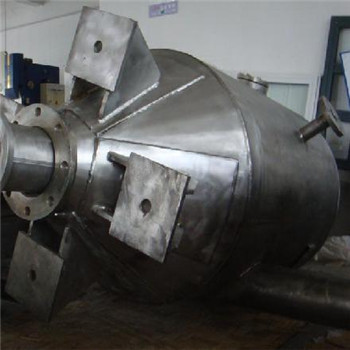Titanium equipment in the use of chlor-alkali production
The largest users of titanium equipment (35%) are metal chloride, sulfates and inorganic fertilizers based on them. These production units are characterized by the presence of a corrosive process medium. Whereas titanium has a very high corrosion resistance in such mediums. Pitting corrosion occurs in other metals (stainless steel, cast alloy) as structural materials, Pitting corrosion and even rupture.
Now built on experience, titanium equipment can be successfully used for almost all of the chlor-alkali production section. Tubular heat exchangers for brine preheating can run for years without maintenance. The use of stainless steel heat exchangers every 8-10 days will have to stop over and over again (in the corrosion of the pipe repair welding, and remove drugs).
The use of titanium heat exchangers to cool wet and chlorine water can greatly simplify the cooling and drying processes, becoming more compact and sound, as well as reducing chlorine loss and chlorine contamination of the wastewater. Due to this tranquil condition, the dryness can reach very high, thus creating a condition for the stable operation of the compressor section.
Use of graphite tube scrapped 2 to 3 years. Titanium tube can be used for more than 10 years. Titanium barberry tubes eliminate crusting on the tube surface and maintain a high level of heat transfer; all new heat exchangers used in the chloride chemistry unit are composed of titanium.
In the mercury electrolysis, it is important to prevent iron, Ming, vanadium, molybdenum and other salt of salt water pollution. Salt dechlorination tank, evaporator and pump are also observed of titanium.
Titanium is the most economical material for making such pumps when using the diaphragm and mercury processes to produce chlor-alkali, sodium hypochlorite and calcium hypochlorite. Titanium pumps have an estimated life of 10 years and utilize titanium cast pumps to deliver saturated chlorine (20% chlorine) and chlorinated brine.
Titanium is the only corrosion-resistant material available for production such as chlorine dioxide, hypochlorite, grade acid salt, perchlorates, chloric acid and the like. For example, when hydrated lime is liquefied in warm weather, the corrosion rate of titanium in this hot environment is no more than 0.001mm / year. Titanium equipment used to make bleached powders in this way found no signs of corrosion after a year and a half of operation, and all stainless steel, regardless of the alloy, suffered severe corrosion in this environment, especially along the weld.
Titanium is used to make its brackets, coolers and stirrers in a Beckmann chamber, which circulates a mixture of chlorine and air against the slaked lime in countercurrent flow, simultaneously with a titanium header and an exhaust grille To extract the used exhaust gas from Beckman's house. This test proved 2-4 years later that the application of titanium can greatly prolong the interval of inspection and maintenance.
Many overseas companies are successfully using titanium equipment (heat exchangers, pumps, storage tanks, filter presses, sprayers, etc.) to produce sodium hypochlorite and calcium hypochlorite.
In recent years, there has become an increasing trend of using titanium as an electrode material in electrochemical production. In the production of chlorine and chlorate, titanium anodes with dynamic layers of ruthenium oxide are widely used. Chlorine produced utilizing anaerobic anodic electrolysis now accounts for 30% of the world's total production. In recent years, graphite anode will be eliminated momentum will continue.
In hydrogen peroxide, perchloric acid, perchlorate and many others, the platinum anode is completely eliminated by the platinum-plated titanium anode and the platinum foil-coated titanium anode.
The caustic soda industry and its affiliated production units are major producers of titanium. In soda ash production, large quantity of titanium is consumed to make the distillate gas cooler and condenser.
The use of thin-walled titanium tubes with a service life of not less than 20 years can increase the heat exchange area of The equipment and the cross-sectional area of The pipe passage in addition to improving heat transfer conditions. This is especially important for distillation condensers, as the gas escaping as the filtrate heats up may reduce the cross-sectional area of The tube passage. Previously used pipe, in addition to poor corrosion resistance (service life of not more than three years) there is a shortcoming, which is due to the formation of thick rust layer, resulting in the pipe thermal conductivity greatly reduced.









